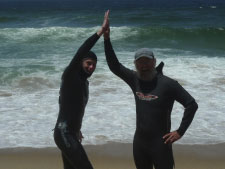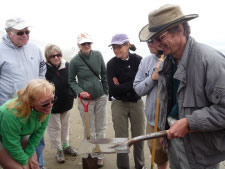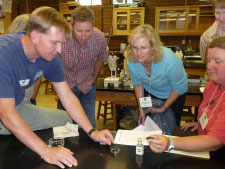COSEE-PP, a regional Center funded in 2007 serving Oregon, Washington, California, and Hawai'i, has continued to work in 2010 toward its goal of increasing the participation of scientists in ocean science education, particularly those based at marine laboratories.
Marine laboratories are a dispersed network of research centers with the capacity to reach a wide variety of populations. Marine laboratories are linked in a national network, the National Association of Marine Laboratories (NAML), and also regionally through chapters within NAML. COSEE-PP is centered at two West coast marine labs: the University of Oregon’s Institute of Marine Biology (OIMB) and Oregon State University’s Hatfield Marine Science Center (HMSC). During the first two years of operation we developed and tested a number of innovative programs that connect marine laboratory scientists with community college and informal educator audiences that can be exported to other marine labs.
COSEE-PP PROGRAM MODELS DEVELOPED AT OIMB AND HMSC
 |
| PRIME 2010 Intern Daniel Trovillion and mentor Dr. Alan Shanks, OIMB, after a long day collecting plankton in the surf zone |
Promoting Research Investigations in the Marine Environment
Community colleges have become an important pathway for students intending to complete a baccalaureate degree, although students at these institutions have few opportunities to engage in science research experiences. Promoting Research Investigations in the Marine Environment (PRIME) is an internship program that provides community college students with opportunities to experience research by working with scientists based at marine laboratories. The goals of the program are to increase community college students’ understanding of marine science content and the process of science, science communication skills, and awareness of careers in marine science. Additional goals of the program are to determine if community college students are an appropriate group for a research experience internship; whether marine lab scientists see value in the PRIME program; and how to effectively develop a multi-site internship program. To date 20 students have participated in PRIME at 4 of our marine labs and 16 scientists have served as mentors.
Community College Faculty Professional Development
Over the past three years, COSEE-PP has worked to develop professional development programs whose goals are to increase the ability of community college (2YC) faculty to learn about and use current ocean science information in their teaching activities, as well as to build a community of 2YC faculty and scientists to support learning in the community colleges.
The science faculty at community colleges play an important role in providing ocean science education for undergraduates. The 2YC science curriculum serves a large number of non-science students, and a smaller number of students who enter the ocean science work force. Community colleges provide access to a diverse audience; on a national scale, 53% of Hispanics, 45% of African Americans, 52% of Native Americans and 40% of first generation college students in higher education are enrolled at community colleges. Classes that include ocean science topics are taught in a variety of departments by faculty who may or may not be ocean scientists. Since 2008 COSEE-PP has worked with 85 2YC faculty and 34 ocean scientists to improve the quality, and increase the quantity, of ocean science content of 2YC courses by providing a variety of professional development opportunities for 2YC faculty ranging from day-long workshops to week-long intensive institutes.
The national coverage and regional nature of the COSEE Centers makes them ideally suited for partnerships with community colleges. It allows for the development of opportunities that connect ocean scientists with community college faculty, who are often place-based and have large teaching loads and few resources for professional development.
 |
| Dr. Stewart Schultz, OIMB, and volunteers in the Coastal Master Naturalist Program explore organisms of the sandy shore |
Coastal Master Naturalist Program
Modeled on similar successful programs nationwide, the Coastal Master Naturalist Program (CMNP) seeks to develop highly trained volunteers engaging in ocean sciences education, stewardship and citizen science. This effort dovetails with a larger effort in Oregon to create a statewide Oregon Master Naturalist Program developed around five bioregions, the coast being one of them. COSEE-PP has taken the lead in a partnership with regional volunteer-based organizations to support the development and implementation of a CMNP for Oregon by working with scientists to develop a modular curriculum that incorporates current knowledge of the ocean and the ocean literacy principles. The participation of scientists is crucial for ensuring that the volunteers who elect to participate in the program receive current, accurate information.
In 2010, we identified scientists who piloted several modules of the CMNP curriculum and presented material to adult participants, some of whom are currently volunteers in marine and aquatic education and stewardship programs coast-wide in Oregon. Scientist involvement in the training of volunteers who can communicate effectively about the ocean to a variety of audiences has long-term implications. Programs such as the CMNP are replicable nationwide and could contribute to building capacity for ocean education.
EXPANSION TO COSEE-PP MARINE LAB PARTNERS
This year, as a test of this dispersed network, we continued activities at the two Oregon marine labs and expanded them to three additional Pacific marine laboratories. Each of these labs is engaging their scientists to develop programs based on COSEE-PP models and tailored to their specific needs, often using products developed by the COSEE Network that support our Center goals.
 |
Dr. Jude Apple, SPMC, and community college faculty work on an ocean
acidification lab activity |
Western Washington University – Shannon Point Marine Center
For the past two summers, Shannon Point Marine Center (SPMC) Director Dr. Steve Sulkin has hosted community college student interns in the PRIME program. This summer Dr. Jude Apple, SPMC Marine Scientist & Public Education Specialist, offered a week-long workshop on current oceanographic topics with their scientists and local community college faculty.
SPMC has strong connections with the Northwest Indian College and the Padilla Bay National Estuarine Research Reserve, and is engaging both institutions in their activities. They are currently developing a Communicating Ocean Sciences for Informal Audiences (COSIA) course.
University of Hawai'i – Kewalo Marine Laboratory
This summer scientists at the Kewalo Marine Laboratory (KML)incorporated three PRIME interns, two from community colleges in Hawai'i and one from American Samoa Community College, into the existing Undergraduate Mentoring in Environmental Biology internship program at the University of Hawai'i at Manoa, also funded by the National Science Foundation. With the expansion of PRIME to four marine labs, we are exploring ways to facilitate interaction between the interns. This summer we created a PRIME blog and interns in Oregon and Washington watched the Hawai'i interns’ final presentations via videoconference or online via live streaming video.
Dr. Mike Hadfield, Professor of Zoology at the University of Hawai'i KML, and Dr. Gail Grabowsky, Associate Professor and Director of the Environmental Studies program Chaminade University, are leading the COSEE-PP efforts in Hawai'i. They recently conducted a needs assessment with science faculty and administrators at Pacific Island community colleges in Guam, Saipan, Palau, Yap, Pohnpei, Majuro and American Samoa. They learned which resources faculty could most use to enhance their marine science education programs and planned for faculty professional development activities that will meet these needs.
COSEE-PP Co-Director Dr. Shawn Rowe is working with Hadfield and Grabowsky on a plan to adapt existing COSIA materials to offer professional development trainings for informal educators working with tour operators/guides, dive guides, eco-tour guides, and environmental volunteers in Hawai'i and the Pacific Islands.
Humboldt State University Marine Laboratory
Dr. Sean Craig, Associate Professor of Marine Ecology, is leading the COSEE-PP efforts at Humboldt State University Marine Laboratory (HSUML). This fall Craig, Rowe, and COSEE-PP Coordinator Coral Gehrke plan to offer a 3-day COSIA-based workshop for scientists, graduate students and informal education partners. The goals of the workshop are to help HSU offer the COSIA course and to generate new opportunities for faculty and graduate students at HSUML to work directly with regional informal education audiences.
The expansion of COSEE-PP activities from two marine laboratories in Oregon to three additional marine laboratories in Washington, California, and Hawai'i serves as a test and possible model for further engagement of marine laboratory scientists in the COSEE Network.
To learn more about COSEE-PP activities contact Coral Gehrke or visit the COSEE-PP website.

